This Hawaiian island's 'freakosystems' are a warning from the future
 Sean MacDonald
Sean MacDonaldEcosystems which have never been seen before are being accidentally created by humans. They offer a stark look into the nature of tomorrow.
Venture deep into the forests on O'ahu, Hawaii's third largest island, and you'll find yourself threading through a dense understory of richly scented pepper, cinnamon and guava trees.
"It's beautiful," says Corey Tarwater, an ecologist at the University of Wyoming in the US who began researching O'ahu's ecosystems in 2014. Sounds like the "cheww-chewww" song of the pale green warbling white-eye and the chattering, almost electrical call of the red-billed leiothrix surround you. "There's really neat lizards around," adds Tarwater. "There's these highly structured forests with these amazing tropical plant species."
For hikers setting out on O'ahu's mountain trails, these are thrilling wildernesses within easy reach of Hawaii's capital, Honolulu, says Tarwater. Yet nothing is quite as it might seem, she adds. "You wouldn't know unless you study them, but if you walk around any forest around Honolulu, there's not going to be one single native plant species there."
O'ahu's lowland forests are now almost entirely devoid of the plants and animals that grew here for millions of years before the arrival of humans. Settlers brought extinctions by cutting down trees to make farms and introducing voracious predators and disease-carrying animals. Today, these tropical forests are a tapestry of non-native species introduced from every corner of the planet: Brazilian peppertree, Indonesian cinnamon and roseleaf bramble from the Himalayas and Australia. Most of the animals, including all the birds that Tarwater mentioned earlier, are also alien.
O'ahu's mountainous terrain – a filming location that has evoked heroic, untrammelled wildernesses in the Jurassic Park and King Kong films – is shaped "at every level" by human action, says Jef Vizentin-Bugoni, a Brazilian ecologist at Universidade Federal de Pelota who researched the island's birds with Tarwater. He recalls having his expectations upturned when he arrived on the island in 2017, eager to see Hawaii's famous honeycreepers, a set of brightly coloured native bird species that exist nowhere else in the world. Instead, he was first confronted with an unfamiliar flurry of red and white feathers, which turned out to be a red-whiskered bulbul, a bird whose native range spans from India to Southern China.
"I followed it as it flitted between trees until it stopped to feed on a fruit I immediately recognised – guava, a plant native to Brazil," he says. "That moment captured the essence of what's happening in Hawaii: a South American plant being eaten by an Asian bird on a remote Pacific island."
Most of these exotic species arrived in the last century or two and were thrown together more or less at random – some are escaped pets, others relics from abandoned farms. Yet unlike urban environments where foxes and seagulls scratch together a living eating anything they can find, the forests of O'ahu show signs of structure and organisation.
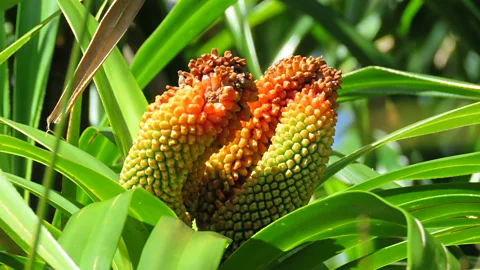 Jef Vizentin-Bugoni
Jef Vizentin-BugoniBirds that have only lived together for the last century have assumed specialist roles, such as distributing the seeds of native plants, that were once performed by now extinct birds. In a 2019 study, Tarwater and Vizentin-Bugoni analysed the eating patterns of birds and seed dispersal on the island to see how they compared to a structured and stable native ecosystem that had evolved together over millennia.
"If I compare what I'm seeing in O'ahu with what I see in the middle of the Amazon, will the interactions have the same organisation?" asked Vizentin-Bugoni. "To our surprise, the answer was yes."
Human-made ecosystems
For the last few decades, ecologists have documented the appearance of "emerging" or "novel ecosystems" like that on O'ahu. Broadly, novel ecosystems can be defined as "autonomous, wild ecosystems that deviate from natural baselines because of human activities", explains ecologist Jens-Christian Svenning, a professor at Aarhus University in Denmark who studies these ecosystems. Novel ecosystems may contain combinations of species never before seen in history: with some native species living alongside other species introduced by humans beyond their historically recorded ranges or driven into new locations by climate change.
Humans may also alter the environment itself, creating new habitats by reshaping the landscape or altering environmental chemistry. For example, along the coast of the Netherlands, marine ecologist Laura Govers has documented how a system of coastal defences like dams and sea walls, built during the mid-20th Century, has created a series of salty lakes where exotic species have flourished.
In Brazil, rainforests cleared for farming have later become freshwater floodplains, known as várzeas, which are home to a new mix of species. Similarly, retired quarries can fill with water to become deep lakes, and even mines have become valued habitats.
One former shale oil mine between the Scottish cities of Edinburgh and Glasgow left a mountain made of stone, says Eric Higgs, professor of ecology at the University of Victoria in Canada. Over at least a century piles of stone formed a novel ecosystem through natural assembly processes, says Higgs. It is now a specially protected area that harbours rare plants such as the early purple orchid and the tiny white flowers of the knotted pearlwort.
Unlike zoos and botanical gardens, which also contain globe-spanning collages of plants and animals, novel ecosystems like those on O'ahu are not dependent on humans to continually plant and maintain them. They now exist as self-sustaining systems, says Svenning. "These are wild but changed ecosystems," he says. They have passed some critical threshold which means they are unlikely to ever go back to how they were before. "If you removed all people from the planet, Hawaii would be on a different evolutionary ecological trajectory going forward," he says.
So how much of the planet is already covered by novel ecosystems like these? Some analyses have arrived at startling figures – in a 2013 book on novel ecosystems, researchers argued that 30-40% of the world's terrestrial ecosystems have already transformed into novel states. A study by Svenning projected that half of the land on the planet would be novel by 2100.
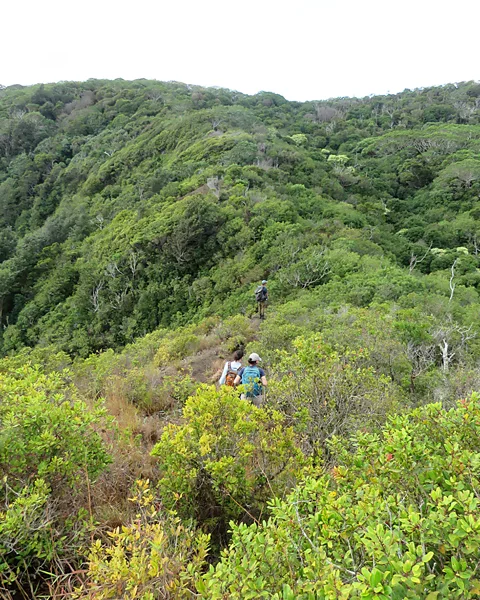 Jef Vizentin-Bugoni
Jef Vizentin-BugoniHowever, these figures – like much around "novel ecosystems" – remain highly controversial among ecologists. Critics argue that scientists often cannot clearly define when a threshold of novelty has been passed. There are plenty of cases that are "kind of borderline", says Svenning. For example, power plants in Florida and Japan are venting warm water that has created tropical microenvironments with an abundance and variety of species not seen in the surrounding cooler waters.
"They don't depend on direct active management," like zoos, Svenning says. "But they still rely on ongoing human activity to be there, right?"
Hawaii's nature laboratory
For the last decade, says Vizentin-Bugoni, scientists have studied O'ahu as an "amazing crystal ball" that offers a glimpse of the future of our planet if humans continue to damage environments and drive species to extinction.
For millions of years, the remote location of the Hawaiian archipelago, some 2,000 miles (3,200km) from its nearest neighbour (the US mainland), made it a petri dish for the emergence of unique species. After the islands first emerged from the ocean as lifeless rocks erupting from volcanoes between 30 million and 500,000 years ago, plants and animals arrived there extremely rarely. Migrating birds were the exception, along with the seeds they deposited in their droppings.
Hawaii's plants and the birds that remained there therefore evolved largely in isolation from the rest of the world, leading to the evolution of species found nowhere else on the planet, from "flightless ibises to bird-hunting owls", writes anthropologist Todd Braje in his 2024 book Understanding Imperiled Earth. Without any mammals or large predators of any kind, unique birds evolved to fill diverse niches, like the moa-nalo, (or "flightless megaducks", as Braje calls them) that grew to 2ft (0.6m) in height and helped to disperse large seeds and cycle nutrients on the islands.
Of the 142 species of bird that evolved to live on Hawaii and nowhere else on the planet, 95 are now extinct, including the moa-nalo, according to the American Bird Conservancy. Similar trends among plants and invertebrates have earned it the label of the "extinction capital of the world".
Hawaii's islands are a "microcosm" of the issues countries worldwide face from exotic species, according to 2020 research led by Liba Pejchar, a conservation scientist at the University of Colorado. The arrival of humans – first small groups of Polynesian sailors around 1,000 years ago, later Europeans in 1778 – resulted in forest clearances and the introduction of rats, dogs and cows. For birds, the greatest threat today is the mosquito, which since the 1800s has spread avian malaria that can kill native birds with a single bite.
"We like to think of O'ahu as the cautionary tale for all the other Pacific Islands and the Hawaiian Islands," says Tarwater. "It's what you don't want to have happen."
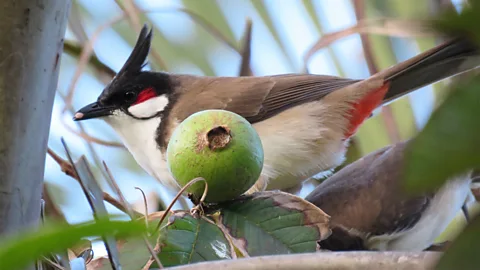 Jef Vizentin-Bugoni
Jef Vizentin-BugoniUnsurprisingly, when Tarwater began meticulously tagging Hawaiian birds, non-native species had a bad rap. "When we first started working out on O'ahu, we were asked by people why we didn't just shoot the [non-native] birds," says Tarwater. But by instead observing them, her and Vizentin-Bugoni's team discovered that several of the last native fruiting plants, such as the violet berried uki'uki which clings on in pockets high up the mountains, are wholly dependent on non-native birds to disperse seeds.
"It was shocking to us that they were just so embedded into these systems," says Tarwater. Still, it's a "double-edged sword", she says. "Unfortunately, they also disperse our non-native plants," she says – which can, in turn, crowd out the endangered natives.
During a decade investigating the rich networks that have self-assembled here, both Tarwater and Vizentin-Bugoni have been amazed to find the extent to which ecosystems have meshed together. In a 2020 paper, Tarwater showed that the traits and bodies of non-native birds have shifted in areas they have invaded – some, for example, have smaller bills, better for eating O'ahu's smaller fruits. On O'ahu you can now watch mysterious flocks of numerous species take off together in search of fruit. This behaviour is also seen in the Amazon, but in O'ahu the flocks are made up of birds from all around the planet, from the Himalayas to South America.
'Unrestorable' ecosystems
For the profoundly and irreversibly changed environments we see in O'ahu, the most intuitive name might have come not from a scientist at all but from Higgs' young daughter: she has dubbed them "freakosystems", he says. Since these strange places began to gain recognition in the late 1990s, the biggest question has been what environmentalists should do about them.
Invasive species
Deliberately and accidentally, humans have introduced countless species of animals, plants and other organisms to non-native biomes. While most new additions are innocuous, more than 37,000 species have been found to harm native species, habitats and ecosystems, causing them to be labelled invasive, according to the United Nations' Intergovernmental Science-Policy Platform on Biodiversity and Ecosystem Services (IPBES).
Globally, invasive non-native species are one of the top five drivers of global biodiversity loss, according to IPBES, contributing to 60% of global extinctions and causing damages worth $423bn (£323bn) per year.
Restoration ecologists have been on the frontlines of answering this question, says Higgs. Traditionally, these scientists have aimed to recover degraded landscapes towards some reference point – often, in the Americas, this was set about the time that European colonies began arising in the Americas. The idea was to restore ecosystems to a pre-disturbance or pre-human state.
But in many places – including islands like Hawaii and New Zealand, where so many species of plants and animals have gone extinct and non-native species have spread so far – turning back the clock was clearly impossible. This idea of "practical unrestorability" became the hallmark of what a novel ecosystem is, says Higgs.
Faced with these challenges, ecologists began to question how useful it would be to follow traditional conservation strategies, such as eradicating non-native "invasive" species – typically defined as an introduced species that harms its new environment. But it is not always easy, in much-changed environments, to identify which species these are.
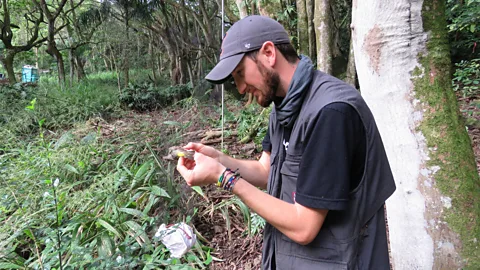 Jef Vizentin-Bugoni
Jef Vizentin-BugoniTake, for example, the packs of feral donkeys or "burros" that roam the American South and Australia, the descendants of working animals once used widely in mines and mills that were turned loose decades ago. In places where feral donkeys and horses have competed with native herbivores and overgrazed plants, some local governments have resorted to large-scale culls.
But research has shown that donkeys also dig water holes – known as wells or "ass holes" – in many cases providing the only water source in drylands where temperatures can reach almost 50C (122F). In the Sonoran Desert, which spans the US and Northern Mexico, these holes support more than 50 other species, including birds and large native mammals such as mule deer. Mountain lions have even been observed eating donkeys.
Meanwhile in Australia, introduced megafauna – from feral horses and donkeys to camels and water buffalo – often make drylands more functionally similar to the ancient past, when 200kg (440lb) giant wombats dug holes in the country's interior, Svenning's research has shown.
Yet for nature lovers brought up to value pristine environments, and having long ago learned of the destruction wrought by invasive black rats or cane toads, novel ecosystems challenge many of the fundamental values that have driven conservation for decades. In 2011, when the writer Emma Marris published the influential book Rambunctious Garden, which explored novel ecosystems, critics responded that she was giving permission to "trash nature". Like Marris, many urban communities have come to love novel environments that have arisen in their local neighbourhoods. Mount Sutro, for example, a forest of non-native eucalyptus, has become a much-loved park in San Francisco, says Higgs.
As climate change and nature-loss continue, ecologists are adapting their language to acknowledge that many ecosystems have "novel elements" or degrees of "ecological novelty". A new map published by researchers in March 2025, tracked how ecosystems across the planet were being changed by climate change, the loss of key animals and native plants being replaced by invasive species. Matthew Kerr, a researcher in Svenning's lab at Aarhus University who made the map, says he found that novel habitats are now truly global, with more than half of the earth's land highly changed: "This extended out to protected areas," he says, including nature parks and marine reserves.
Responding to these findings, ecologist Anna Walentowitz at the University of Bayreuth in Germany wrote that ecological novelty is now the "new normal" for our planet, forcing us to question how we protect nature today.
Discovering what works
O'ahu, at least, is teaching us important lessons that can help protect other environments not yet so degraded, including other islands where native ecosystems remain healthier, says Vizentin-Bugoni. Research has spotlighted certain species that set alarm bells ringing, as they are most likely to do harm to surrounding ecosystems.
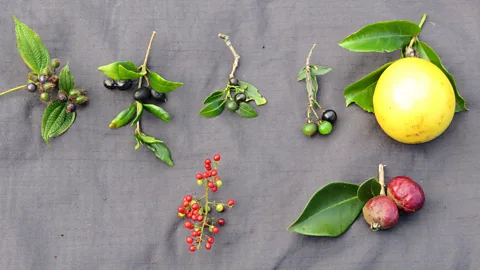 Jef Vizentin-Bugoni
Jef Vizentin-Bugoni"For the plants, the ones that are most likely to be a problem are the ones that fruit for a long period and also have small seeds," he says. Both these characteristics increase the chance of being eaten by birds and spread around rapidly.
On O'ahu itself, research into novel ecosystems is guiding more unconventional conservation strategies. Most land managers are aiming to safeguard the 87% of native plants threatened with extinction by meticulously removing invasive plant species from "these tiny restoration sites", explains Tarwater. Although this allows native plants to grow without competition, these denuded areas quickly become bird-free zones, she says. "There's not enough fruit in those areas to attract them there, which isn't good [for native plants], if those are the only things left to disperse their fruits."
To get the birds to spread native plants around, the team in O'ahu instead try to trick them. They use speakers to play the calls of "birds that we know are really good seed dispersers" to lure them to restoration sites where native plants remained, Tarwater says. "Once they're there, they're like: 'Oh, hey, look at that fruit!' and they'll eat it." (Read about how scientists coax back species with sound in other parts of the world too.)
Such strategies work with non-native birds to help conserve the tiny patches of remaining native plants – although many roles, such as the moa-nalos' dispersal of large seeds, are still not filled, as no non-native species are big enough.
It all makes unravelling what to do with these novel habitats difficult. "It's complex and depends on the goals of restoration," says Tarwater. A conservationist focusing on native plants may eradicate as many non-native competitors as possible, she says. "But if you're interested in conserving a native snail or some of these other species, that [non-native plant] might be the habitat that they currently rely upon."
While novel ecosystems remain controversial, on O'ahu, conservationists and land managers have become less black-and-white about native and non-native species, says Tarwater.
"We know that the challenges of the novel ecosystems are going to remain, and likely increase. We know that it's not as simple as them being good or bad."
--
For essential climate news and hopeful developments to your inbox, sign up to the Future Earth newsletter, while The Essential List delivers a handpicked selection of features and insights twice a week.
